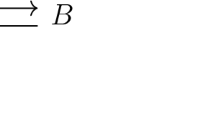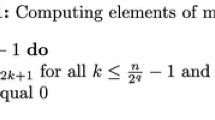Abstract
Reaction and diffusion processes are used to model chemical and biological processes over a wide range of spatial and temporal scales. Several routes to the diffusion process at various levels of description in time and space are discussed and the master equation for spatially discretized systems involving reaction and diffusion is developed. We discuss an estimator for the appropriate compartment size for simulating reaction–diffusion systems and introduce a measure of fluctuations in a discretized system. We then describe a new computational algorithm for implementing a modified Gillespie method for compartmental systems in which reactions are aggregated into equivalence classes and computational cells are searched via an optimized tree structure. Finally, we discuss several examples that illustrate the issues that have to be addressed in general systems.



























Similar content being viewed by others
Notes
Other scalings may be applicable in other regimes, but would lead to different evolution equations (Hillen and Othmer 2000).
These estimates are predicated on a uniform distribution of species in the compartments. They could be very different if there are spatial gradients, but estimates are difficult in that case.
Here and hereafter we assume that block sizes are chosen so that N c is a multiple of m.
References
Agbanusi, I. C., & Isaacson, S. A. (2013). A comparison of bimolecular reaction models for stochastic reaction diffusion models. arXiv:1301.0547.
Ander, M., Beltrao, P., Di Ventura, B., Ferkinghoff-Borg, J., Foglierini, M., Kaplan, A., Lemerle, C., Tomas-Oliveira, I., & Serrano, L. (2004). SmartCell, a framework to simulate cellular processes that combines stochastic approximation with diffusion and localisation: analysis of simple networks. Syst. Biol., 1(1), 129–138.
Applebaum, D. (2004). Lévy processes and stochastic calculus (Vol. 93). Cambridge: Cambridge University Press.
Arnold, L. (1974). Stochastic differential equations, theory and applications. New York: Wiley-Interscience.
Ashkenazi, M., & Othmer, H. G. (1978). Spatial patterns in coupled biochemical oscillators. J. Math. Biol., 5, 305–350.
Bernstein, D. (2005). Simulating mesoscopic reaction–diffusion systems using the Gillespie algorithm. Phys. Rev. E, 71(4 Pt 1), 041103.
Callen, H. B. (1960). Thermodynamics. New York: Wiley.
Cao, Y., Li, H., & Petzold, L. (2004). Efficient formulation of the stochastic simulation algorithm for chemically reacting systems. J. Chem. Phys., 121(9), 4059–4067.
Capasso, V., & Bakstein, D. (2005). An introduction to continuous-time stochastic processes: theory, models, and applications to finance, biology, and medicine. New York: Birkhauser.
Chueh, K. N., Conley, C. C., & Smoller, J. A. (1977). Positively invariant regions for systems of nonlinear diffusion equations. Indiana University Math. J., 26(2), 373–392.
Conway, E., Hoff, D., & Smoller, J. (1978). Large time behavior of solutions of systems of nonlinear reaction–diffusion equations. SIAM J. Appl. Math., 35(1), 1–16.
Elf, J., & Ehrenberg, M. (2004). Spontaneous separation of bi-stable biochemical systems into spatial domains of opposite phases. IET Syst. Biol., 1, 230–236.
Erban, R., & Othmer, H. (2005). From signal transduction to spatial pattern formation in E. coli: a paradigm for multi-scale modeling in biology. Multiscale Model. Simul., 3(2), 362–394.
Erban, R., & Othmer, H. G. (2007). Taxis equations for amoeboid cells. J. Math. Biol., 54(6), 847–885.
Gadgil, C., Lee, C. H., & Othmer, H. G. (2005). A stochastic analysis of first-order reaction networks. Bull. Math. Biol., 67, 901–946.
Gibson, M. A., & Bruck, J. (2000). Efficient exact stochastic simulation of chemical systems with many species and many channels. J. Phys. Chem. A, 104, 1876–1889.
Gierer, A., & Meinhardt, H. (1972). A theory of biological pattern formation. Biol. Cybern., 12(1), 30–39.
Gillespie, D. T. (1977). Exact stochastic simulation of coupled chemical reactions. J. Phys. Chem., 81(25), 2340–2361.
Hillen, T., & Othmer, H. G. (2000). The diffusion limit of transport equations derived from velocity jump processes. SIAM J. Appl. Math., 61, 751–775.
Isaacson, S. A. (2009). The reaction–diffusion master equation as an asymptotic approximation of diffusion to a small target. SIAM J. Appl. Math., 70(1), 77–111.
Kang, H. W., Zheng, L., & Othmer, H. G. (2012). A new method for choosing the computational cell in stochastic reaction–diffusion systems. J. Math. Biol., 65, 1017–1099.
Kang, H. W., Zheng, L., & Othmer, H. G. (2012). The effect of the signalling scheme on the robustness of pattern formation in development. Interface Focus, 2(4), 465–486.
Li, H., & Petzold, L. (2006). Logarithmic direct method for discrete stochastic simulation of chemically reacting systems (Technical Report). Department of Computer Science, University of California, Santa Barbara.
Matzavinos, A., & Othmer, H. G. (2007). A stochastic analysis of actin polymerization in the presence of twinfilin and gelsolin. J. Theor. Biol., 249, 723–736.
Metzler, R., & Klafter, J. (2000). The random walk’s guide to anomalous diffusion: a fractional dynamics approach. Phys. Rep., 339(1), 1–77.
Othmer, H. G. (1976). Nonuniqueness of equilibria in closed reacting systems. Chem. Eng. Sci., 31, 993–1003.
Othmer, H. G. (1977). Current problems in pattern formation. In Some mathematical questions in biology (Vol. VIII, pp. 57–85). Providence: Am. Math. Soc.
Othmer, H. G., Dunbar, S. R., & Alt, W. (1988). Models of dispersal in biological systems. J. Math. Biol., 26, 263–298.
Othmer, H. G., & Aldridge, J. A. (1978). The effects of cell density and metabolite flux on cellular dynamics. J. Math. Biol., 5, 169–200.
Othmer, H. G., & Xue, C. (2013). The mathematical analysis of biological aggregation and dispersal: progress, problems and perspectives. In M. Lewis, P. Maini, & S. Petrovskii (Eds.), Dispersal, individual movement and spatial ecology: a mathematical perspective, Heidelberg: Springer.
Prigogine, I., & DeFay, R. (1954). Chemical thermodynamics. New York: Longmans, Green.
Sato, K. I. (1999). Lévy processes and infinitely divisible distributions. Cambridge: Cambridge University Press.
Shimmi, O., & O’Connor, M. B. (2003). Physical properties of Tld, Sog, Tsg and Dpp protein interactions are predicted to help create a sharp boundary in Bmp signals during dorsoventral patterning of the Drosophila embryo. Development, 130(19), 4673–4682.
Tomioka, R., Kimura, H., Kobayashi, T. J., & Aihara, K. (2004). Multivariate analysis of noise in genetic regulatory networks. J. Theor. Biol., 229(4), 501–521.
Turing, A. M. (1952). The chemical basis of morphogenesis. Philos. Trans. R. Soc. Lond. B, Biol. Sci., 237, 37–72.
Umulis, D. M., & Othmer, H. G. (2013). Mechanisms of scaling in spatial pattern formation. Development (to appear).
Weiss, G. H. (1994). Aspects and applications of the random walk. Amsterdam: North-Holland.
Wilemski, G. (1976). On the derivation of Smoluchowski equations with corrections in the classical theory of Brownian motion. J. Stat. Phys., 14(2), 153–169.
Xue, C., & Othmer, H. G. (2009). Multiscale models of taxis-driven patterning in bacterial populations. SIAM J. Appl. Math., 70(1), 133–167.
Xue, C., Budrene, E. O., & Othmer, H. G. (2011). Radial and spiral stream formation in Proteus mirabilis colonies. PLoS Comput. Biol., 7(12), e1002332.
Acknowledgements
Research supported in part by Grant # GM 29123 from the National Institutes of Health, and in part by the Mathematical Biosciences Institute and the National Science Foundation under grant DMS 0931642.
Author information
Authors and Affiliations
Corresponding author
Rights and permissions
About this article
Cite this article
Hu, J., Kang, HW. & Othmer, H.G. Stochastic Analysis of Reaction–Diffusion Processes. Bull Math Biol 76, 854–894 (2014). https://doi.org/10.1007/s11538-013-9849-y
Received:
Accepted:
Published:
Issue Date:
DOI: https://doi.org/10.1007/s11538-013-9849-y




